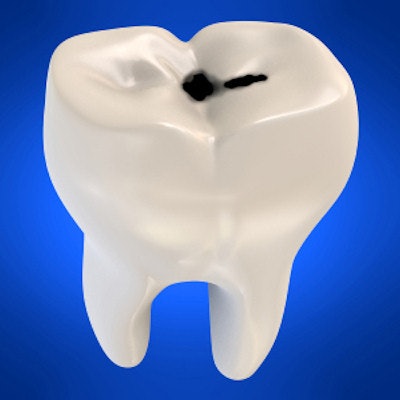
Existing caries assessment methods typically don't account for decay in both primary and permanent teeth. Enter the Total Observed Caries Experience (TOCE) measure, which its creator says offers distinct benefits compared with other methods.
The developer of TOCE proposes its use as an outcome measure in public health dentistry to assess community-based caries prevention. In a study published in the Journal of Public Health Dentistry (August 16, 2018), he compared its results for evaluating a community-based caries prevention program for children with other caries measures and found it to be a robust method.
"Having a measure such as TOCE, which aggregates the total accumulated decayed or filled teeth during observation, can be used to understand the total amount of disease experienced by children over a long period of time," study author Ryan Ruff, MPH, PhD, told DrBicuspid.com.
Dr. Ruff is an assistant professor of epidemiology and health promotion at NYU College of Dentistry in New York City.
No caries uncounted
Dr. Ruff previously developed TOCE while analyzing data from a large caries prevention program in children.
"We needed a measure that would be easily understood and could adjust for exfoliation, mixed dentition, and new and existing dental caries that occur with unequal distribution over time," he noted.
Dr. Ruff defined TOCE as the total number of caries and fillings in primary and permanent dentition observed over time for use as an alternative measure for assessing community-based caries prevention.
“TOCE ... can be used to understand the total amount of disease experienced by children over a long period of time.”
He conducted the current study using data from a previously conducted study to compare TOCE with commonly used measures for evaluating caries prevention study data. These were dmft (decayed, missing, filled primary teeth), DMFT (decayed, missing, filled permanent teeth), and the prevalence of untreated decay on any dentition.
TOCE is the sum of the total number of teeth with either untreated decay or restoration, such as filling, at each observational period, regardless of whether the affected tooth had undergone natural primary tooth loss by the time of subsequent observations.
Dr. Ruff used data from a four-year study performed in 682 primary school-aged children in the Philippines who had an average age of 7 years and received one of three treatments randomized at the school level: daily toothbrushing with fluoride toothpaste, daily toothbrushing with fluoride toothpaste plus access to urgent care if they had toothaches from advanced caries, or daily toothbrushing with fluoride toothpaste plus weekly application of a high-concentration fluoride gel. A control group took part in a standard health education program that included a physical exam and oral health messaging.
"I wanted to understand how these indices perform in high-risk, high-disease children as they age and receive different treatments," Dr. Ruff told DrBicuspid.com.
At baseline, the average dmft was 5.80, average DMFT was 1.23, and average TOCE was 4.58, with 95% of children having untreated decay on any tooth and 52% on any permanent tooth. During the study, the prevalence of untreated decay on any permanent tooth increased to 91% of participants.
Longitudinal models the author developed found that the risk of dmft decreased significantly over time. Untreated decay on any teeth decreased nonsignificantly. However, DMFT and TOCE both increased significantly over time.
Compared with the control group, models for dmft and DMFT showed a significant increase in risk of decay for some experimental groups, while others showed a significant decrease. For untreated decay, all groups showed increased risk of decay compared with the control group. Model results for TOCE found that no groups were significantly different from the control group.
"Because TOCE accounts for all observed decayed or filled teeth across both primary and permanent dentition, it more accurately reflects the total accumulated disease and is not biased due to tooth exfoliation," Dr. Ruff concluded in his article.
Benefits of the measure include its ability to be used even if study participants receive dental care outside of a study or if observational periods are not evenly spaced. Dr. Ruff noted that this measure better reflects accumulated disease, is not biased due to tooth exfoliation, and appears useful for evaluating caries prevention programs.
Potential applications unknown
Dr. Ruff emphasized that TOCE was developed to evaluate caries prevention programs and has not been used for other purposes, so its effectiveness for other uses is unknown.
At the same time, he is working on caries prevention studies comparing silver diamine fluoride with sealants that will use TOCE as one of the outcomes, and he is also developing a simulation model for children of various ages to further test the behavior of TOCE.
"TOCE is useful for those interested in the practice and study of public health dentistry," Dr. Ruff told DrBicuspid.com. "Typically, this research is not as controlled as a laboratory-based randomized control trial. It's important to remember that the estimated impact of caries prevention or other programs may vary depending on the specific outcome used in evaluation."



















